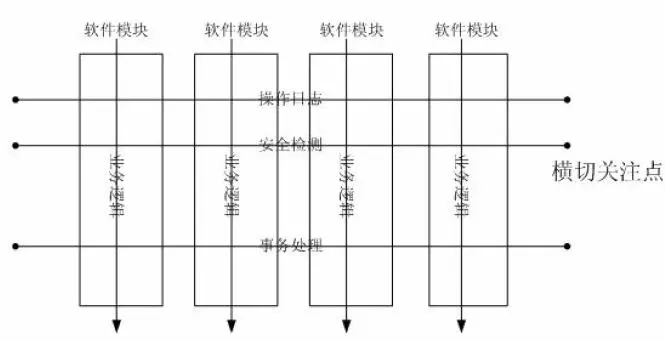有一个接口Dao有insert、delete、update三个方法,在insert与update被调用的前后,打印调用前的毫秒数与调用后的毫秒数。
首先定义一个Dao接口:
/**
* @author 五月的仓颉
http://www.cnblogs.com/xrq730/p/7003082.html
*/
public interface Dao {
public void insert();
public void delete();
public void update();
}然后定义一个实现类DaoImpl:
/**
* @author 五月的仓颉
http://www.cnblogs.com/xrq730/p/7003082.html
*/
public class DaoImpl implements Dao {
@Override
public void insert() {
System.out.println("DaoImpl.insert()");
}
@Override
public void delete() {
System.out.println("DaoImpl.delete()");
}
@Override
public void update() {
System.out.println("DaoImpl.update()");
}
}最原始的写法,我要在调用insert()与update()方法前后分别打印时间,就只能定义一个新的类包一层,在调用insert()方法与update()方法前后分别处理一下,新的类我命名为ServiceImpl,其实现为:
/**
* @author 五月的仓颉
http://www.cnblogs.com/xrq730/p/7003082.html
*/
public class ServiceImpl {
private Dao dao = new DaoImpl();
public void insert() {
System.out.println("insert()方法开始时间:" +
System.currentTimeMillis());
dao.insert();
System.out.println("insert()方法结束时间:" +
System.currentTimeMillis());
}
public void delete() {
dao.delete();
}
public void update() {
System.out.println("update()方法开始时间:" +
System.currentTimeMillis());
dao.update();
System.out.println("update()方法结束时间:" +
System.currentTimeMillis());
}
}这是最原始的写法,这种写法的缺点也是一目了然:
方法调用前后输出时间的逻辑无法复用,如果有别的地方要增加这段逻辑就得再写一遍
如果Dao有其它实现类,那么必须新增一个类去包装该实现类,这将导致类数量不断膨胀
使用装饰器模式
接着我们使用上设计模式,先用装饰器模式,看看能解决多少问题。装饰器模式的核心就是实现Dao接口并持有Dao接口的引用,我将新增的类命名为LogDao,其实现为:
/**
* @author 五月的仓颉
http://www.cnblogs.com/xrq730/p/7003082.html
*/
public class LogDao implements Dao {
private Dao dao;
public LogDao(Dao dao) {
this.dao = dao;
}
@Override
public void insert() {
System.out.println("insert()方法开始时间:" +
System.currentTimeMillis());
dao.insert();
System.out.println("insert()方法结束时间:" +
System.currentTimeMillis());
}
@Override
public void delete() {
dao.delete();
}
@Override
public void update() {
System.out.println("update()方法开始时间:" +
System.currentTimeMillis());
dao.update();
System.out.println("update()方法结束时间:" +
System.currentTimeMillis());
}
}在使用的时候,可以使用"Dao dao = new LogDao(new DaoImpl())"的方式,这种方式的优点为:
透明,对调用方来说,它只知道Dao,而不知道加上了日志功能
类不会无限膨胀,如果Dao的其它实现类需要输出日志,只需要向LogDao的构造函数中传入不同的Dao实现类即可。
不过这种方式同样有明显的缺点,缺点为:
输出日志的逻辑还是无法复用。
输出日志的逻辑与代码有耦合,如果我要对delete()方法前后同样输出时间,需要修改LogDao。
但是,这种做法相比最原始的代码写法,已经有了很大的改进。
使用代理模式
接着我们使用代理模式尝试去实现最原始的功能,使用代理模式,那么我们就要定义一个InvocationHandler,我将它命名为LogInvocationHandler,其实现为:
/**
* @author 五月的仓颉
http://www.cnblogs.com/xrq730/p/7003082.html
*/
public class LogInvocationHandler implements InvocationHandler {
private Object obj;
public LogInvocationHandler(Object obj) {
this.obj = obj;
}
@Override
public Object invoke(Object proxy, Method method, Object[] args) throws Throwable {
String methodName = method.getName();
if ("insert".equals(methodName) || "update".equals(methodName)) {
System.out.println(methodName + "()方法开始时间:" +
System.currentTimeMillis());
Object result = method.invoke(obj, args);
System.out.println(methodName + "()方法结束时间:" +
System.currentTimeMillis());
return result;
}
return method.invoke(obj, args);
}
}其调用方式很简单,我写一个main函数:
/**
* @author 五月的仓颉
http://www.cnblogs.com/xrq730/p/7003082.html
*/
public static void main(String[] args) {
Dao dao = new DaoImpl();
Dao proxyDao = (Dao)Proxy.newProxyInstance(
LogInvocationHandler.class.getClassLoader(),
new Class<?>[]{Dao.class}, new LogInvocationHandler(dao));
proxyDao.insert();
System.out.println("----------分割线----------");
proxyDao.delete();
System.out.println("----------分割线----------");
proxyDao.update();
}结果就不演示了,这种方式的优点为:
输出日志的逻辑被复用起来,如果要针对其他接口用上输出日志的逻辑,只要在newProxyInstance的时候的第二个参数增加Class数组中的内容即可。
这种方式的缺点为:
JDK提供的动态代理只能针对接口做代理,不能针对类做代理。
代码依然有耦合,如果要对delete方法调用前后打印时间,得在LogInvocationHandler中增加delete方法的判断。
使用CGLIB
接着看一下使用CGLIB的方式,使用CGLIB只需要实现MethodInterceptor接口即可:
/**
* @author 五月的仓颉
http://www.cnblogs.com/xrq730/p/7003082.html
*/
public class DaoProxy implements MethodInterceptor {
@Override
public Object intercept(Object object, Method method, Object[] objects,
MethodProxy proxy) throws Throwable {
String methodName = method.getName();
if ("insert".equals(methodName) || "update".equals(methodName)) {
System.out.println(methodName + "()方法开始时间:" +
System.currentTimeMillis());
proxy.invokeSuper(object, objects);
System.out.println(methodName + "()方法结束时间:" +
System.currentTimeMillis());
return object;
}
proxy.invokeSuper(object, objects);
return object;
}
}代码调用方式为:
/**
* @author 五月的仓颉
http://www.cnblogs.com/xrq730/p/7003082.html
*/
public static void main(String[] args) {
DaoProxy daoProxy = new DaoProxy();
Enhancer enhancer = new Enhancer();
enhancer.setSuperclass(DaoImpl.class);
enhancer.setCallback(daoProxy);
Dao dao = (DaoImpl)enhancer.create();
dao.insert();
System.out.println("----------分割线----------");
dao.delete();
System.out.println("----------分割线----------");
dao.update();
}使用CGLIB解决了JDK的Proxy无法针对类做代理的问题,但是这里要专门说明一个问题:使用装饰器模式可以说是对使用原生代码的一种改进,使用Java代理可以说是对于使用装饰器模式的一种改进,但是使用CGLIB并不是对于使用Java代理的一种改进。
前面的可以说改进是因为使用装饰器模式比使用原生代码更好,使用Java代理又比使用装饰器模式更好,但是Java代理与CGLIb的对比并不能说改进,因为使用CGLIB并不一定比使用Java代理更好,这两种各有优缺点,像Spring框架就同时支持Java Proxy与CGLIB两种方式。
从目前看来代码又更好了一些,但是我认为还有两个缺点:
无论使用Java代理还是使用CGLIB,编写这部分代码都稍显麻烦。
代码之间的耦合还是没有解决,像要针对delete()方法加上这部分逻辑就必须修改代码。
使用AOP
最后来看一下使用AOP的方式,首先定义一个时间处理类,我将它命名为TimeHandler:
/**
* @author 五月的仓颉
http://www.cnblogs.com/xrq730/p/7003082.html
*/
public class TimeHandler {
public void printTime(ProceedingJoinPoint pjp) {
Signature signature = pjp.getSignature();
if (signature instanceof MethodSignature) {
MethodSignature methodSignature = (MethodSignature)signature;
Method method = methodSignature.getMethod();
System.out.println(method.getName() + "()方法开始时间:" +
System.currentTimeMillis());
try {
pjp.proceed();
System.out.println(method.getName() + "()方法结束时间:" +
System.currentTimeMillis());
} catch (Throwable e) {
}
}
}
}到第8行的代码与第12行的代码分别打印方法开始执行时间与方法结束执行时间。我这里写得稍微复杂点,使用了的写法,其实也可以拆分为与两种,这个看个人喜好。
这里多说一句,切面方法printTime本身可以不用定义任何的参数,但是有些场景下需要获取调用方法的类、方法签名等信息,此时可以在printTime方法中定义JointPoint,Spring会自动将参数注入,可以通过JoinPoint获取调用方法的类、方法签名等信息。
由于这里我用的,要保证方法的调用,这样才能在方法调用前后输出时间,因此不能直接使用JoinPoint,因为JoinPoint没法保证方法调用。此时可以使用ProceedingJoinPoint,ProceedingPointPoint的proceed()方法可以保证方法调用,但是要注意一点,ProceedingJoinPoint只能和搭配,换句话说,如果aop.xml中配置的是,然后printTime的方法参数又是ProceedingJoinPoint的话,Spring容器启动将报错。
接着看一下aop.xml的配置:
<?xml version="1.0" encoding="UTF-8"?>
<beans xmlns="http://www.springframework.org/schema/beans"
xmlns:xsi="http://www.w3.org/2001/XMLSchema-instance"
xmlns:aop="http://www.springframework.org/schema/aop"
xmlns:tx="http://www.springframework.org/schema/tx"
xsi:schemaLocation="http://www.springframework.org/schema/beans
http://www.springframework.org/schema/beans/spring-beans-3.0.xsd
http://www.springframework.org/schema/aop
http://www.springframework.org/schema/aop/spring-aop-3.0.xsd">
<bean id="daoImpl" class="org.xrq.spring.action.aop.DaoImpl" />
<bean id="timeHandler" class="org.xrq.spring.action.aop.TimeHandler" />
<aop:config>
<aop:pointcut id="addAllMethod" expression="execution(* org.xrq.spring.action.aop.Dao.*(..))" />
<aop:aspect id="time" ref="timeHandler">
<aop:before method="printTime" pointcut-ref="addAllMethod" />
<aop:after method="printTime" pointcut-ref="addAllMethod" />
</aop:aspect>
</aop:config>
</beans>我不大会写expression,也懒得去百度了,因此这里就拦截Dao下的所有方法了。测试代码很简单:
/**
* @author 五月的仓颉
http://www.cnblogs.com/xrq730/p/7003082.html
*/
public class AopTest {
@Test
@SuppressWarnings("resource")
public void testAop() {
ApplicationContext ac = new ClassPathXmlApplicationContext("spring/aop.xml");
Dao dao = (Dao)ac.getBean("daoImpl");
dao.insert();
System.out.println("----------分割线----------");
dao.delete();
System.out.println("----------分割线----------");
dao.update();
}
}结果就不演示了。到此我总结一下使用AOP的几个优点:
切面的内容可以复用,比如TimeHandler的printTime方法,任何地方需要打印方法执行前的时间与方法执行后的时间,都可以使用TimeHandler的printTime方法
避免使用Proxy、CGLIB生成代理,这方面的工作全部框架去实现,开发者可以专注于切面内容本身
代码与代码之间没有耦合,如果拦截的方法有变化修改配置文件即可
下面用一张图来表示一下AOP的作用:

我们传统的编程方式是垂直化的编程,即A-->B-->C-->D这么下去,一个逻辑完毕之后执行另外一段逻辑。但是AOP提供了另外一种思路,它的作用是在业务逻辑不知情(即业务逻辑不需要做任何的改动)的情况下对业务代码的功能进行增强,这种编程思想的使用场景有很多,例如事务提交、方法执行之前的权限检测、日志打印、方法调用事件等等。
AOP使用场景举例
上面的例子纯粹为了演示使用,为了让大家更加理解AOP的作用,这里以实际场景作为例子。
第一个例子,我们知道MyBatis的事务默认是不会自动提交的,因此在编程的时候我们必须在增删改完毕之后调用SqlSession的commit()方法进行事务提交,这非常麻烦,下面利用AOP简单写一段代码帮助我们自动提交事务(这段代码我个人测试过可用):
/**
* @author 五月的仓颉
http://www.cnblogs.com/xrq730/p/7003082.html
*/
public class TransactionHandler {
public void commit(JoinPoint jp) {
Object obj = jp.getTarget();
if (obj instanceof MailDao) {
Signature signature = jp.getSignature();
if (signature instanceof MethodSignature) {
SqlSession sqlSession = SqlSessionThrealLocalUtil.getSqlSession();
MethodSignature methodSignature = (MethodSignature)signature;
Method method = methodSignature.getMethod();
String methodName = method.getName();
if (methodName.startsWith("insert") ||
methodName.startsWith("update") ||
methodName.startsWith("delete")) {
sqlSession.commit();
}
sqlSession.close();
}
}
}
}这种场景下我们要使用的aop标签为,即切在方法调用之后。
这里我做了一个SqlSessionThreadLocalUtil,每次打开会话的时候,都通过SqlSessionThreadLocalUtil把当前会话SqlSession放到ThreadLocal中,看到通过TransactionHandler,可以实现两个功能:
insert、update、delete操作事务自动提交
对SqlSession进行close(),这样就不需要在业务代码里面关闭会话了,因为有些时候我们写业务代码的时候会忘记关闭SqlSession,这样可能会造成内存句柄的膨胀,因此这部分切面也一并做了
整个过程,业务代码是不知道的,而TransactionHandler的内容可以充分再多处场景下进行复用。
第二个例子是权限控制的例子,不管是从安全角度考虑还是从业务角度考虑,我们在开发一个Web系统的时候不可能所有请求都对所有用户开放,因此这里就需要做一层权限控制了,大家看AOP作用的时候想必也肯定会看到AOP可以做权限控制,这里我就演示一下如何使用AOP做权限控制。我们知道原生的Spring MVC,Java类是实现Controller接口的,基于此,利用AOP做权限控制的大致代码如下(这段代码纯粹就是一段示例,我构建的Maven工程是一个普通的Java工程,因此没有验证过):
/**
* @author 五月的仓颉
http://www.cnblogs.com/xrq730/p/7003082.html
*/
public class PermissionHandler {
public void hasPermission(JoinPoint jp) throws Exception {
Object obj = jp.getTarget();
if (obj instanceof Controller) {
Signature signature = jp.getSignature();
MethodSignature methodSignature = (MethodSignature)signature;
// 获取方法签名
Method method = methodSignature.getMethod();
// 获取方法参数
Object[] args = jp.getArgs();
// Controller中唯一一个方法的方法签名ModelAndView
//handleRequest(HttpServletRequest request,
//HttpServletResponse response) throws Exception;
// 这里对这个方法做一层判断
if ("handleRequest".equals(method.getName()) && args.length == 2) {
Object firstArg = args[0];
if (obj instanceof HttpServletRequest) {
HttpServletRequest request = (HttpServletRequest)firstArg;
// 获取用户id
long userId = Long.parseLong(request.getParameter("userId"));
// 获取当前请求路径
String requestUri = request.getRequestURI();
if(!PermissionUtil.hasPermission(userId, requestUri)) {
throw new Exception("没有权限");
}
}
}
}
}
}毫无疑问这种场景下我们要使用的aop标签为。这里我写得很简单,获取当前用户id与请求路径,根据这两者,判断该用户是否有权限访问该请求,大家明白意思即可。
后记
文章演示了从原生代码到使用AOP的过程,一点一点地介绍了每次演化的优缺点,最后以实际例子分析了AOP可以做什么事情。